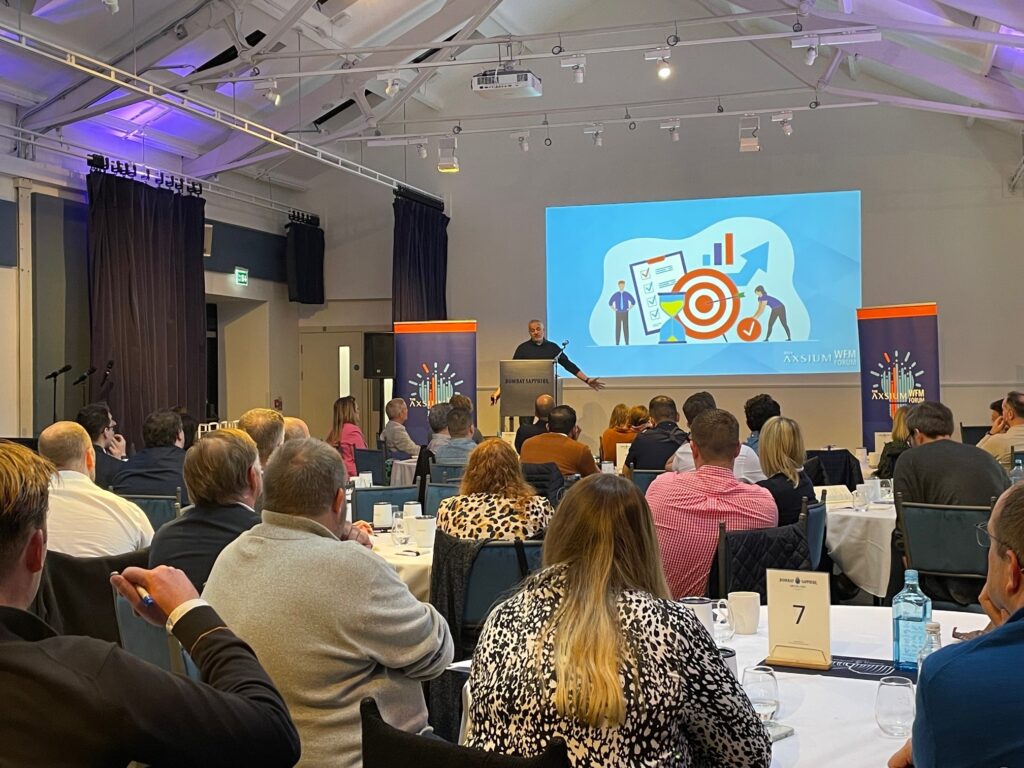On the 17th of October, workforce management experts from some of Europe’s most recognizable brands gathered at the Bombay Sapphire Distillery in Hampshire, England for the 2024 Axsium WFM Forum.
The Forum happens every year. It’s a great way for WFM geeks to get together, network, and learn about the challenges and solutions their peers are facing and implementing. It’s an incredible day and I was very excited to get to experience it for the first time this year.
We had brilliant sessions from the John Lewis Partnership, Midcounties Co-op, Axsium’s own Robin Merrit and Neil Maltby, as well as the Forum’s sponsors, UKG and WorkJam. It was a day of fascinating insights—too many to fit into one small blog—so, I’ve decided to review some of the themes that struck me as the most important.

Getting the Most Out of Artificial Intelligence
The Axsium WFM Forum is all about innovation. How can we push our WFM practices forward to better serve our organisations? Mention innovation today and artificial intelligence springs to everyone’s minds.
The AI discussion started with Axsium’s CSO Robin Merritt. The technology and capabilities are changing at a rapid pace, moving away from chatbots and algorithms. This means, essentially, we’re moving away from limited data sets to generative AI applications that can provide human-like interactions, create new content, and find information like never before.
It’s an exciting time, but I agree with Robin when she suggested we need to ask some questions about AI. The two that stuck with me are two sides of the same coin. What value does AI provide? And what problems will it solve?
Your system tells you that several changes – configurations, rules, and the like – are required to ensure compliance with new legislation and that the AI system will be applying these changes without any further interaction from you. How comfortable would you be letting the system do it by itself?
I was reminded of a recent short post by Rory Sutherland. Rory points out that most student-written essays, while not exactly Shakespearean (he uses more colloquial language), are valuable. That value is gained from the process of research and understanding, not necessarily the essay itself. Yes, AI can write a better essay for you, it doesn’t make you a better essay writer. And that’s true of any system where AI can do something for you.
What Does WFM Success Look Like?
We had two extremely interesting sessions from the John Lewis Partnership and Midcounties Co-op. Both organisations gave us real insights into how they go about their WFM practices.
The John Lewis Partnership talked us through their operations and the department that oversees how they manage their Retail Labour model. Their philosophy of finding the best fit between tasks that need completing and staff availability will sound familiar to many.
When they introduced their current labour model, they needed to redistribute hours between stores to meet demand. But they were only able to spend or allocate budget that already existed. They were not able to hire more staff to meet demand.
This informed their overall philosophy. The JLP team understands that the best time to complete tasks is based on staff availability—they do not redeploy staff to complete tasks. For example, deliveries are timed to arrive when the staff are there to deal with them, rather than bringing staff in to deal with deliveries.
Mid-Counties Co-Op focused on how to maintain the success of an implementation that went well. Alongside regular meetings with their stores to identify and fix issues, the MCC labour model is under regular review and re-evaluation.
For example, when they changed their payroll system, the team found that store managers spent longer interacting with it. This resulted in a knock-on effect to other activities. The team also found the store managers needed further training and involvement with any new technology, system, or policy. The lessons learned: more communication, involve everyone, and provide hybrid training (manuals, webinars, online help, etc.).
The King of the Labour Model
My Axsium colleague Neil Maltby led a fascinating session. Starting off telling us about his lifelong love of motorbikes, he detailed how he began feeling like the “king of the road,” only to experience a crisis of confidence.
A visit to a professional motorcycle racing school made all the difference. Working with unbiased observers helped him to understand the bad habits and incorrect approaches he could fix. But it also helped him to understand new practices and advances in technology that could help him.
Neil’s point was that this maps directly onto what he does for Axsium’s clients as a productivity expert. He is the racing school, observing practices and approaches that could be improved and suggesting new technologies that can help.
Bringing this metaphor back to labour models and accurate labour standards, Neil kicked off a conversation among the audience. There were some insightful comments from attendees about just how impactful accurate labour standards can be. Everyone also agreed that labour models and standards need to be regularly reviewed to maintain alignment with current business requirements.
It was a timely reminder for all of us that, as much as we were there to discuss innovation, it can be valuable to dig back into the basics.

Artificial Intelligence and Beyond
I’ve worked in this industry for a long time and I got a lot out of my first Axsium WFM Forum. Not only were the sessions interesting and engaging, but the discussions at the tables were lively. I learned a lot and met a lot of brilliant WFM professionals making real differences at their organisations.
While innovation was the central theme, the explorations of what artificial intelligence can offer and why we should be cautious were a highlight for me. And, of course, hearing real stories about how teams have implemented changes in their companies was hugely useful.
Am I excited for the next Axsium WFM Forum? Absolutely. And I look forward to hopefully seeing you there, too!
